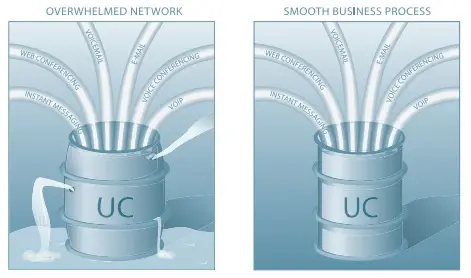While UC enhances business processes, it can overwhelm networks when application performance isn’t closely monitored. Any performance delay will be immediately noticeable to the user.
WHAT YOU NEED TO KNOW
Organizations are always looking for ways to cut expenses. This is particularly true in the current economic climate. Unified communications (UC) represent an appealing alternative to traditional communication processes due to the potential savings once they are implemented. As more companies turn to these alternatives, they also have the potential to struggle with the implementation process and cause headaches for both users and IT staffs. As a result, it is important to develop a basic knowledge of the technology and understand what needs to occur before deployment and what to do once it has been implemented.
UNIFIED COMMUNICATIONS DEFINED
UC applications are often programs involving a combination of network-driven communication tools including Voice over IP (VoIP), Web conferencing, online ollaboration, instant messaging (IM), e-mail, voicemail, and videoconferencing.
While UC enhances business processes, it can overwhelm networks when application performance isn’t closely monitored. Because the success or failure of any UC initiative hangs on the user experience, here are best practices for avoiding performance problems.

A DIFFERENT BREED OF APPLICATION
Before embarking on any UC initiative, it’s important to understand how these applications differ from traditional applications. First, UC bandwidth consumption ranges greatly with the shift to these kinds of applications. For example, if a user checks their e-mail, only a small amount of data is sent over the network and the connection remains idle while the e-mail is read.
However, most UC tools, like web conferencing, are the opposite, requiring high and consistent network bandwidth to maintain performance. As a result, the network engineer must be sure that unexpected spikes from other applications don’t impact the user experience. Any performance delay will be immediately noticeable to the user, whereas e-mail delays are less noticeable.
ESTABLISH BENCHMARKS THROUGH PREDEPLOYMENT TESTING
When implementing a new communications technology such as VoIP, many network managers take one of two approaches. They either install new technologies and address performance problems as they arise, or upgrade bandwidth capacity in anticipation of increased need.
Because of the challenging nature of UC, site surveys and understanding your basic network environment is vital to ensuring a successful roll out. Conducting a site survey before installing UC services can identify and eliminate many performance problems before deployment. Proper predeployment testing also allows IT staff to understand overall bandwidth demand and application performance and establish benchmarks for acceptable network performance. This knowledge is critical for determining how the network will handle new UC traffic and identifying any changes needed to effectively support communications.
An analysis tool that tracks, stores, and analyzes long-term activity will define what is considered normal for a particular environment. The insight into network and application performance gained from the initial survey site and continual monitoring of the added UC traffic also helps in intelligently configuring alarms to alert staff when application performance deviates from the norm.
UNIFIED COMMUNICATIONS AND QOS
UC can be particularly sensitive to network performance, especially to delay and jitter. When implementing any communications application, ensuring bandwidth availability through Quality of Service (QoS) is imperative.
Failing to implement QoS opens up the possibility of interference from other applications on the network, this is known as contention. Contention leads to common performance problems including jitter and packet loss. What IT teams and engineers need to realize is that throwing additional bandwidth at the problem does not solve the issue. Even a network with large bandwidth capacity can have poor call quality due to network contention. With QoS monitoring tools, IT engineers are able to set and outline limits to give individual applications like VoIP the highest precedence available, thus allowing the application to function smoothly by providing the appropriate amount of bandwidth needed.
When monitoring QoS issues, it is also essential for IT engineers to consider the technology as a whole, rather than concentrate on one particular aspect of it. For instance, in the case of VoIP, they will need to set precedence appropriately for all connections composing the call, including set-up and tear-down. A common mistake is setting highest precedence for the conversation and neglecting the other components leading to poor call quality.
SECURITY AND ACCEPTABLE USE POLICIES
While UC applications can boost company performance and lower costs, unprepared IT staffs may not consider how these applications increase the opportunities for sharing information. These applications open up holes through which users can accidentally or maliciously share private data and expose sensitive information. These new holes can also be points of attack if not properly secured.
For example, hackers or users can use tools to capture and play back VoIP conversations. Higher-end VoIP systems may offer ways to encrupt data, but lower-end products often do not. Managers will want to consider this before purchasing a solution. In addition, VoIP traffic is usually most vulnerable on the LAN since Internet WAN traffic is typically routed through VPN’s.
The point is to make sure every communication channel is properly secured and monitored. Acceptable Use Policies should also forbid or provide protocols for the proper sharing of sensitive information.
CONCLUSION
UC can be a tremendous benefit to companies if implemented and configured properly. Companies can receive these advantages without causing undue problems if they take a moment to ensure they are laying the proper groundwork and are aware of what needs to occur once implementation is complete. By following these steps, organizations can avoid many of the pitfalls that can occur.
Thanks to Network Instruments for the article.






